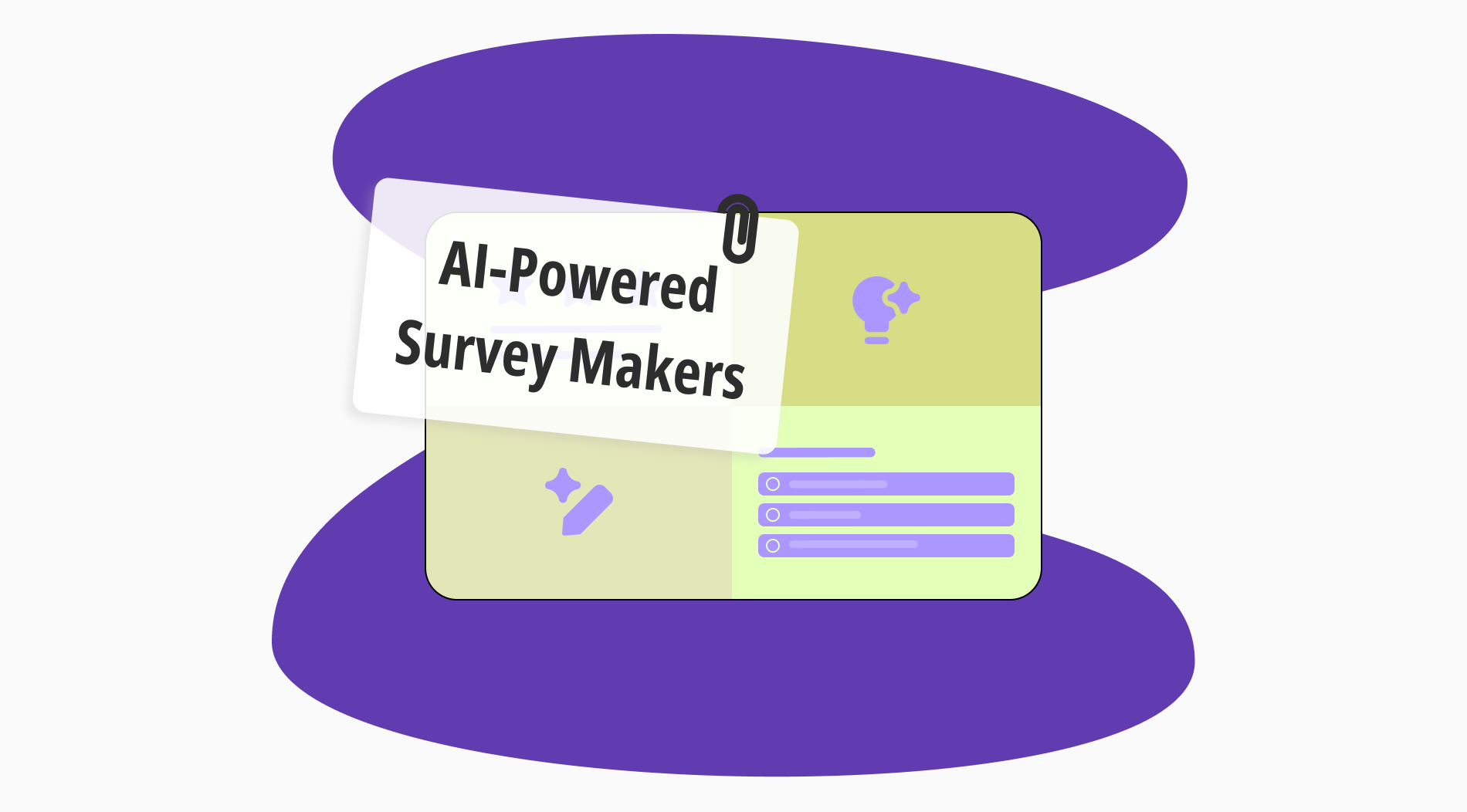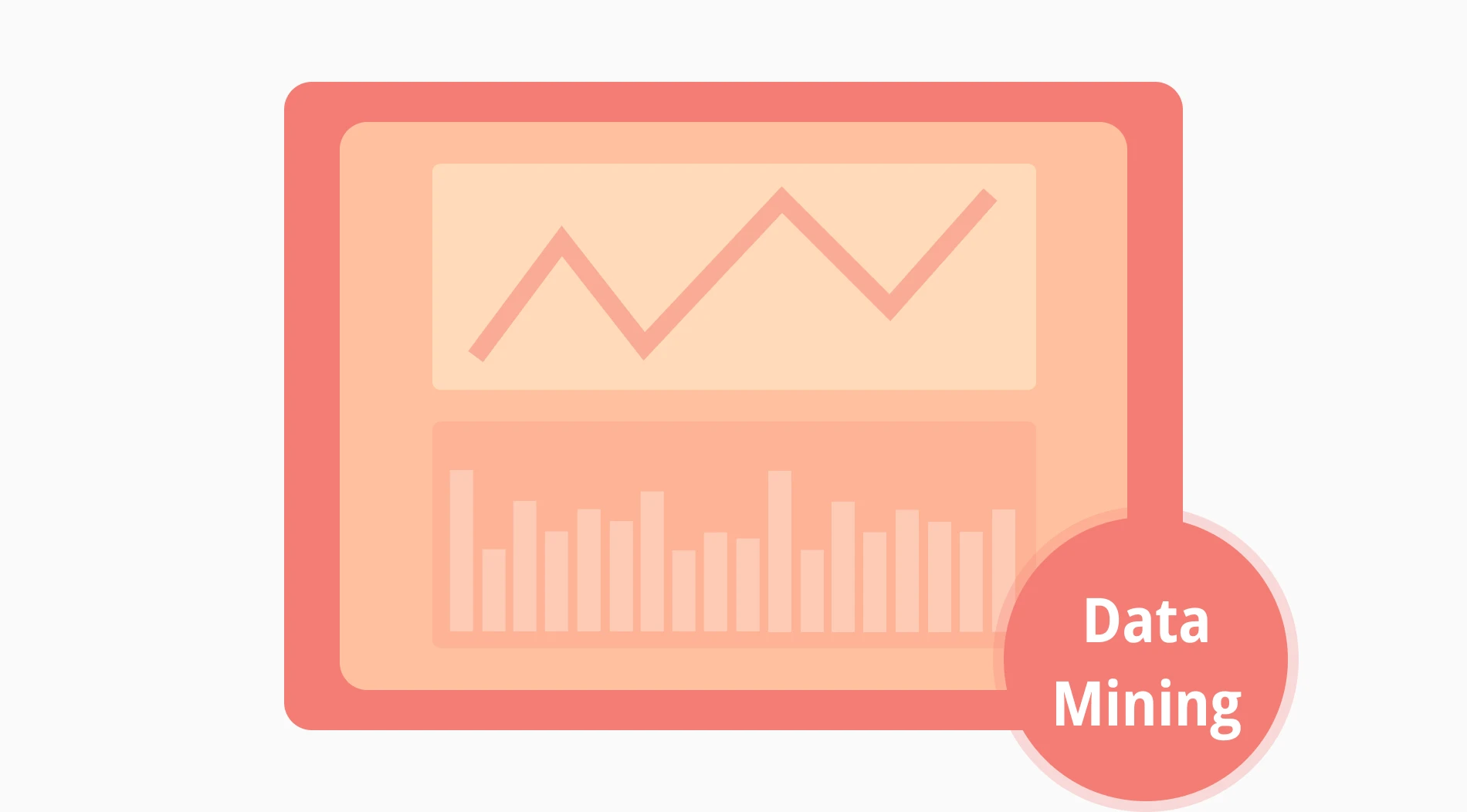
Data is a unique gem, but just as gems are hidden underground, data is also hidden among an infinite amount of information. You have to mine to get the gems from under the ground, and by analogy, data is also something that can be mined.
Mining is not an easy job; you need to have the necessary equipment. This article will provide detailed information about data mining and allow you to perform it. Don't wait any longer; you can start the article by reading the definition of data mining.
What is data mining?

Data mining is a process used to research and analyze large-scale raw data to obtain information that meets a specific purpose or need.
It is utilized as a business intelligence tool to help businesses and organizations. Proper data mining requires statistical and computational techniques. Processed data reveals hidden relationships and patterns in any research and helps make predictions.
When to use data mining
There are many opportunities and crises to use data mining. If you want to understand your customers, then use it. If you want to increase your employee productivity, then use it. Let us share with you a few more examples that you may not have thought of right now:
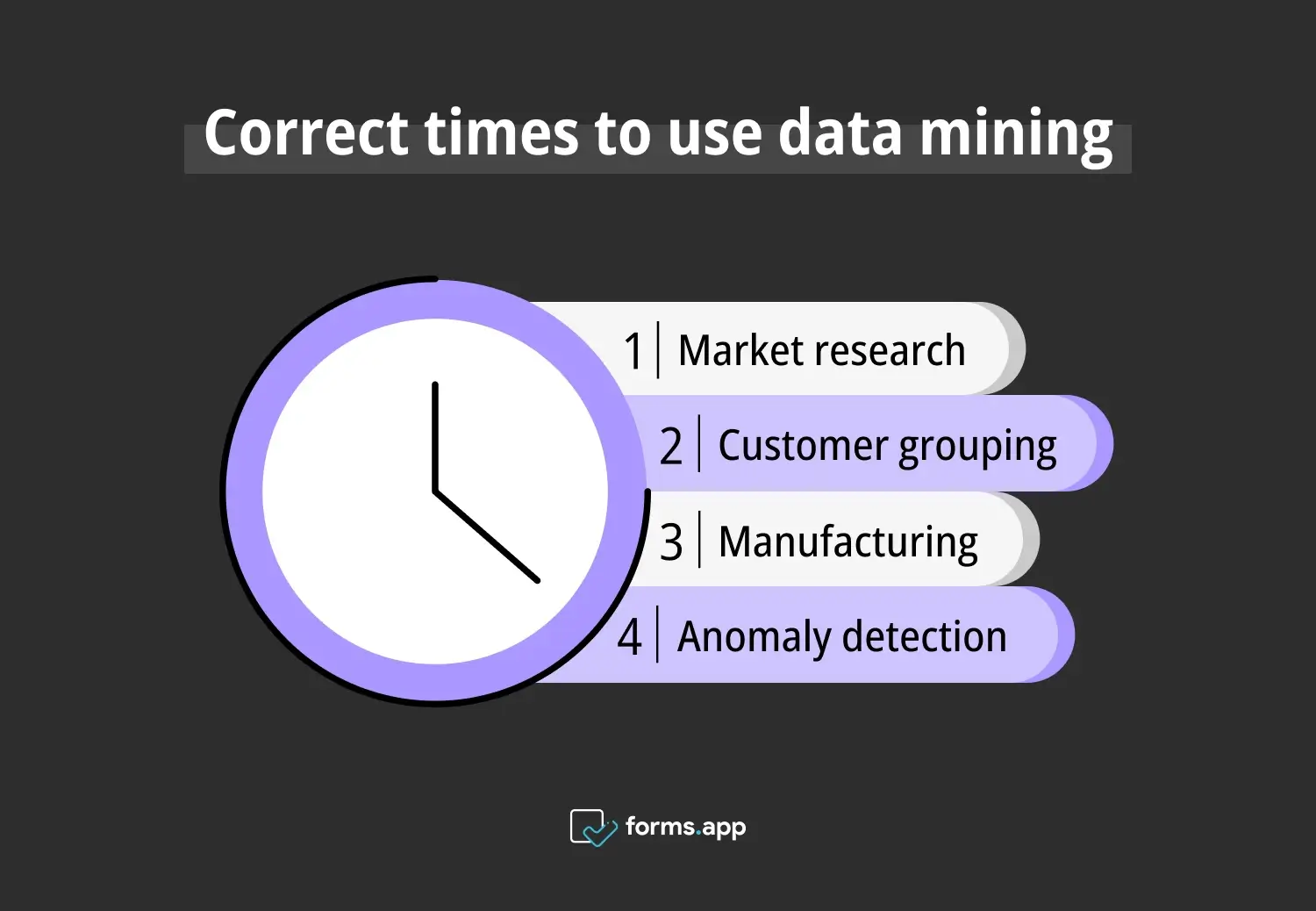
Right times to use data mining
1. Market research: You may have entered a new market, launched a new product, or want to learn about trends. Something like data mining association analysis can help you to see associations among items. Items can be products that frequently co-occur in transactions.
2. Customer grouping: You can group your customers to provide better services and consider their preferences. Of course, you can do this by revealing data about the population.
3. Manufacturing: There are many stages in the production of a product, and calculating the cost and duration of these stages is not always easy. With data mining, you can find and produce materials most effectively in time and money.
4. Anomaly detection: Since data mining can reveal unusual patterns, it can be used to detect fraudulent activities through transaction data. Thus, it can easily detect fraud by analyzing large data sets.
Steps to follow in the data mining process
Determine your purpose and direction before starting data mining. It is different for businesses and education or health institutions, and it is necessary to find data sources accordingly. Then, the data mining process continues by following the steps below:
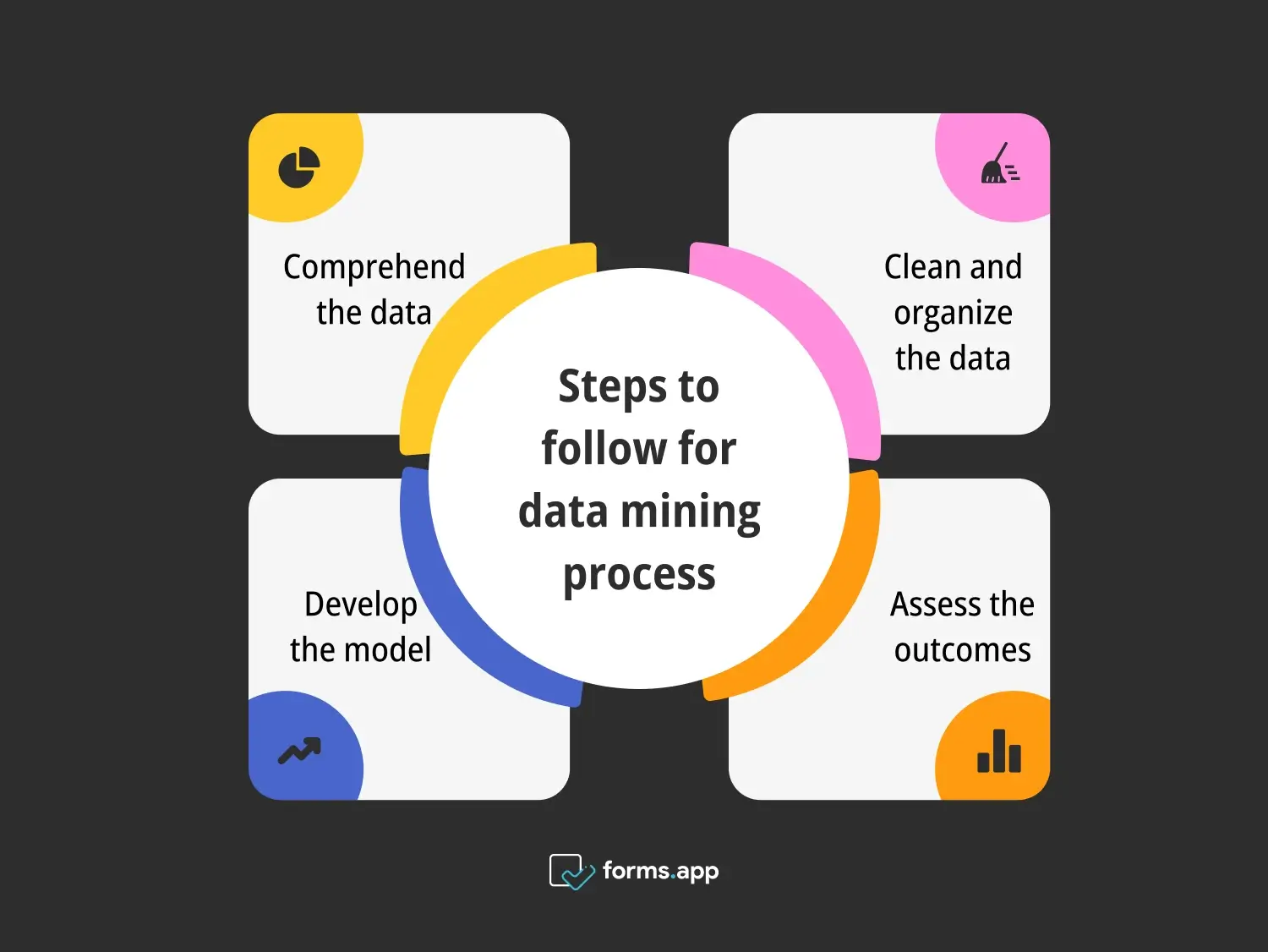
Data mining process steps
1. Comprehend the data
Collecting data is one of the most critical steps because if your foundation is solid, the building you build will also be solid. Scanning the available resources and deciding which ones are suitable for your research is necessary. Understand the type of data, whether it is quantitative or qualitative.
Generally, the most common handicap in data mining is data security. Apart from this, it is also important to determine the data's limits and store the big data.
2. Clean and organize the data
Computational processes begin after the data is collected and transferred to the digital environment. The data at the beginning is a dump, so to speak, and you need to find valuable items in this dump and throw away the others. Erroneous, inappropriate, and illogical data is eliminated. You should also keep the data size at a reasonable level.
3. Develop the model
As will be explained in the next section, it is necessary to develop models using various techniques. These models are used to calculate the numbers in the data set and reveal the data's relationships, patterns, and structures.
4. Assess the outcomes
Now, the data has been collected, cleaned, and interpretable. Analysts can perform this step with the help of artificial intelligence with prescriptive modeling. It is the step where you take the necessary actions in light of the information the data reveals.
Data mining techniques
There is no single method of doing data mining. There is more than one way to obtain valuable outputs. Some methods may be more appropriate depending on the purpose of the research and the nature of the data. Popular data mining analysis methods are as follows:
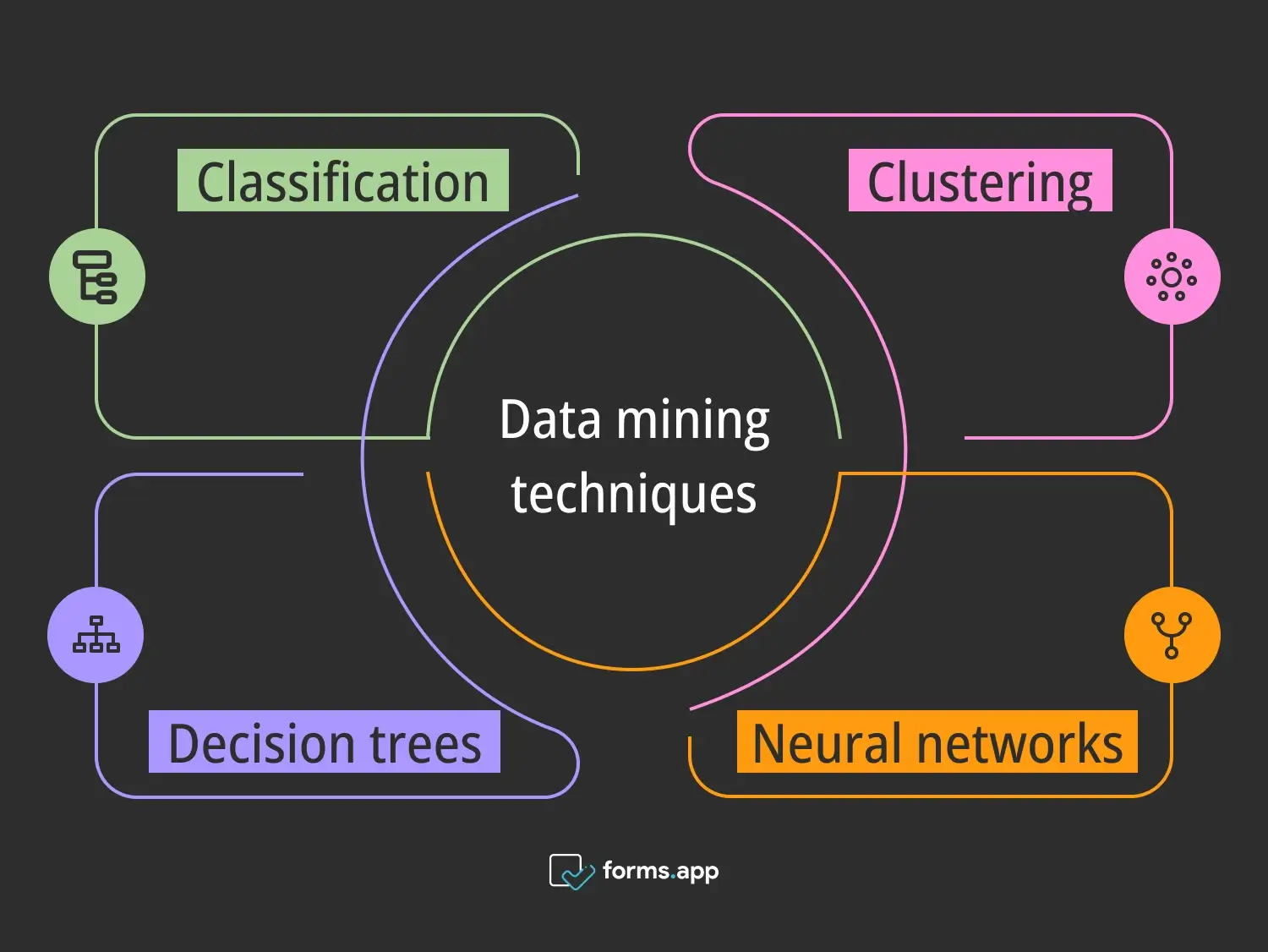
Techniques of data mining
1. Classification
This technique helps to categorize data properly. Data points are divided into predefined classes according to common features. Thus, the summary of the data is revealed.
2. Clustering
This technique divides each object into certain groups. In this respect, it is similar to classification, but the important thing here is to identify the differences and group the same ones together.
3. Decision trees
This technique is actually a simple decision-making scheme. A pattern is created as a result of certain rules and is used to examine the data in depth in a specific direction.
4. Neural networks
With the neural network, an artificial intelligence model, networks between data are created in a way similar to the working principle of the human brain. The nodes in these networks generate an output by assigning weights according to the input.
Pros & cons of data mining
Every helpful thing also has its unseen downsides. Of course, data mining can be a blessing for businesses, but inaccuracies and omissions can lead this process in a very negative direction. So, learn a little about the pros and cons of data mining.
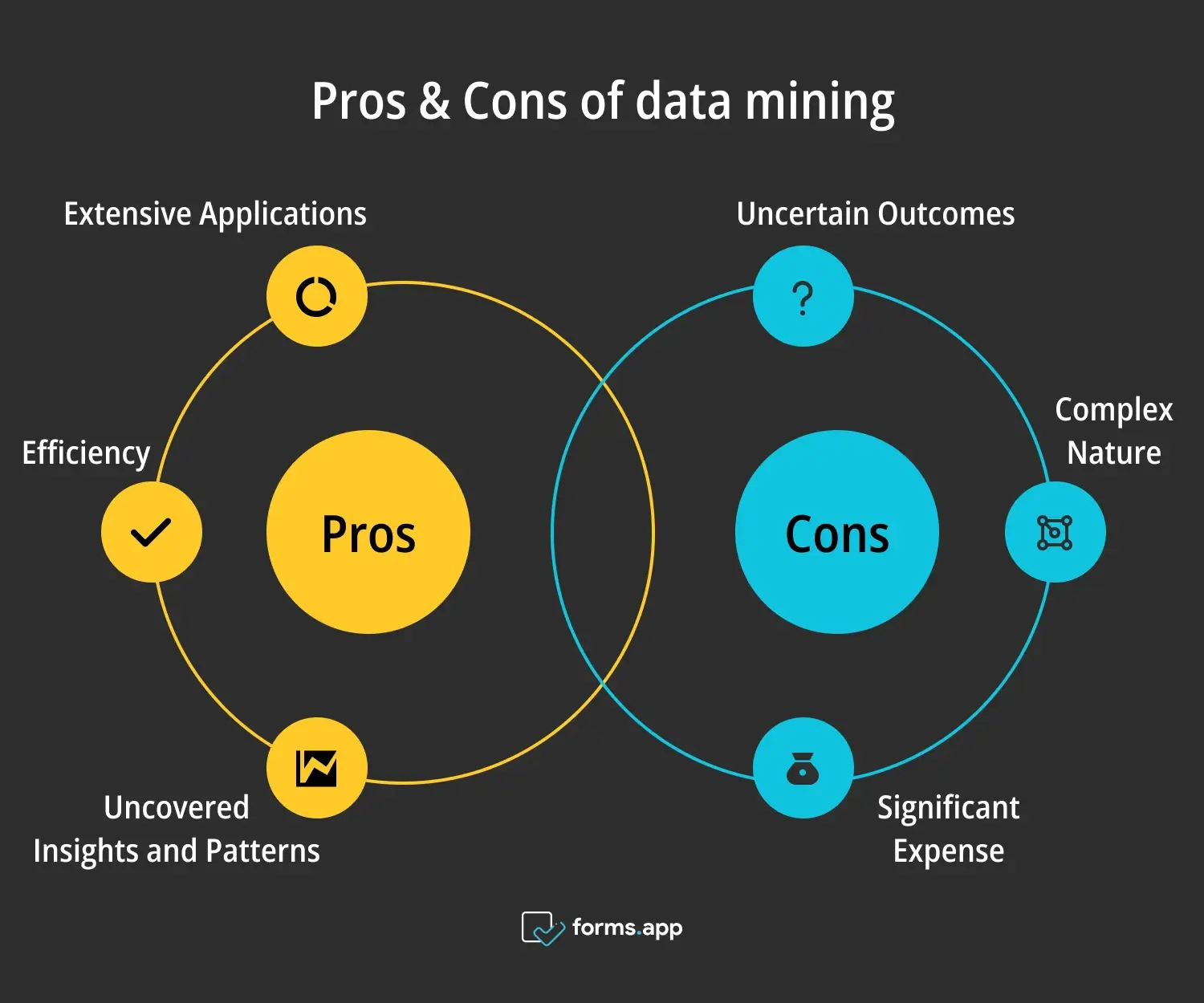
Advantages and disadvantages of data mining
Pros
➕Extensive Applications: Data mining varies widely in its applications, and the fundamental process is adaptable to all systems. Virtually any kind of data can be collected and scrutinized. Businesses and organizations can benefit from this and develop by solving their problems.
➕Uncovered Insights and Patterns: The ultimate goal of data mining is to reveal invisible information. This information is not simple information; it creates an information map with its relationships and patterns with other information. However, it is also necessary to be able to read the map properly, or else all processes will be in vain.
➕Efficiency: Data mining makes data analysis effective. Data analysis helps businesses with their various problems. Thanks to this chain of indirection, businesses can reduce operational costs through data mining.
Cons
➖Uncertain Outcomes: Data mining results may not always be efficient because, as frequently mentioned in the article, your basis may be incomplete or incorrect. It is important to evaluate the results and make the right decisions. Misinterpreting data results will cause you to make wrong decisions.
➖Complex Nature: Data mining requires technical knowledge(such as software and programming languages), so data scientists with knowledge in the field may need to work for you.
➖Significant Expense: The adventure that starts with data collection can be quite expensive with data mining applications and programs. You may need powerful computers to store and process large datasets.
Frequently asked questions about data mining
Since data mining is a very broad topic, you may not want to read every part about it. Instead, you can try to get quick and effective information by taking a look at the frequently asked questions section about data mining.
Veri madenciliği ve analitiği birbiriyle yakından ilişkilidir ve veri biliminin bir parçasıdır. Veri madenciliği başlangıç olarak görülebilir ve veri analitiği orta ve son süreç olarak değerlendirilebilir. Veri madenciliği, keşfedilmemiş verileri ortaya çıkarmayı ve sistemli olarak desenler, ilişkiler, eğilimler ve düzensizlikleri belirlemeyi amaçlar.
Bunu yaparken genellikle yapay zeka (makine öğrenimi) ve istatistik tekniklerinden yararlanır. Öte yandan, veri analitiği daha karmaşık bir sistemdir ve mevcut verileri inceler. Veri sınıflandırma, kodlama, görselleştirme ve yorumlama analizin bir parçasıdır.
Kısacası, evet. Veri madenciliği, yapay zeka alanı olarak kabul edilebilir ancak tamamen yapay zekayla sınırlı değildir. Makine öğrenimi özellikle tercih edilir çünkü birçok karmaşık görevi kolaylaştırır.
Ek olarak, yapay zeka büyük hacimli örnekleri kolayca inceleyebilir ve onlardan değerli bilgiler oluşturabilir. Bu ve benzer nedenlerden dolayı, veri madenciliği yapay zeka ile iç içedir.
Evet, kodlama veri madenciliği süreçlerinde genellikle gereklidir. Bu kodlamalar, veri kümesini etkili bir şekilde analiz etmek amacıyla çeşitli algoritmalar için gereklidir. Veri analizi için tasarlanmış birçok araç ve program bu amaçla kullanılabilir. Bugün kodlama bilgisi gerektirmeyen veri analizi araçları geliştirilmekte olsa da birçok araç hala kodlama becerisi gerektirir.
Veri madenciliğine başlamak için birkaç temel adımı izlemeniz gerekir. Araştırma amacınıza ve toplayacağınız veri kaynaklarına sahip olduğunuzu varsayarak aşağıdaki şekilde ilerleyebilirsiniz:
- Öncelikle, veri madenciliği için uygun bir araç veya program bulun. En yaygın kullanılanları Python ve R gibi programlama dilleridir.
- Veri madenciliği kavramlarını anlamanız ve öğrenmeniz gerekir. Biraz kodlama öğrenmeniz gerekebilir. Bunun dışında, videolar veya bloglar yardımıyla sınıflandırma, kümeleme ve regresyon analizi gibi temel teknikleri öğrenin.
- Veri madenciliği algoritmalarını kullanın ve bu modellerin performansını test edin.
Final words
In conclusion, data mining is a pillar that keeps the modern business world afloat. Businesses eliminate uncertainties about the present and the future with the information provided by data mining. On the other hand, since it has many different application areas, it helps with different techniques on different subjects.
This article has been prepared as a tutorial for those who want to learn about data mining and have questions in mind. First of all, the definition of data mining and examples of when it can be used are given. Then, how this process works and the data mining techniques you can apply are explained. Finally, the article comes to an end by describing the pros and cons.
From now on, data mining will be a concept you know better!
Atakan is a content writer at forms.app. He likes to research various fields like history, sociology, and psychology. He knows English and Korean. His expertise lies in data analysis, data types, and methods.



 6 dakikalık okuma
6 dakikalık okuma